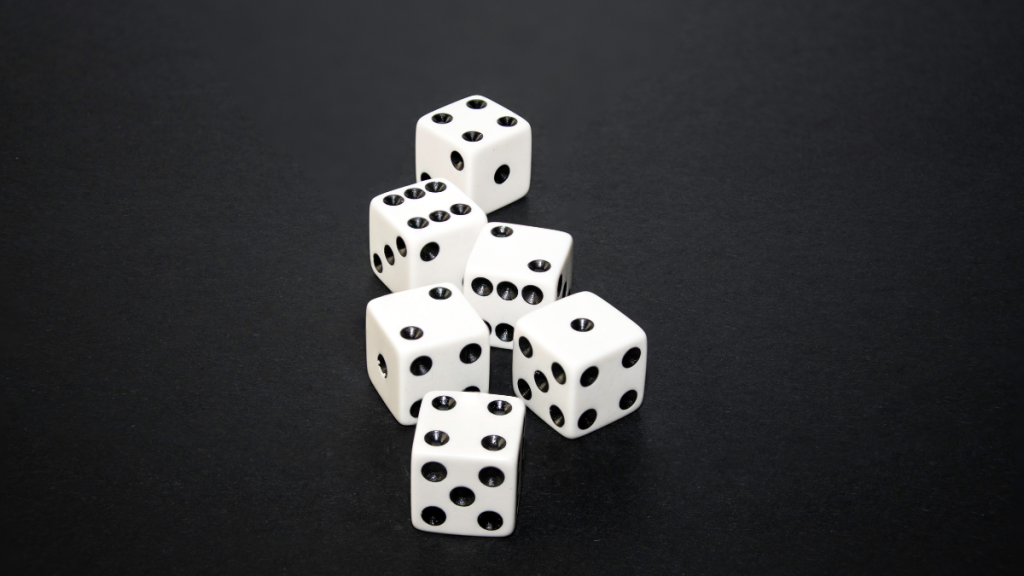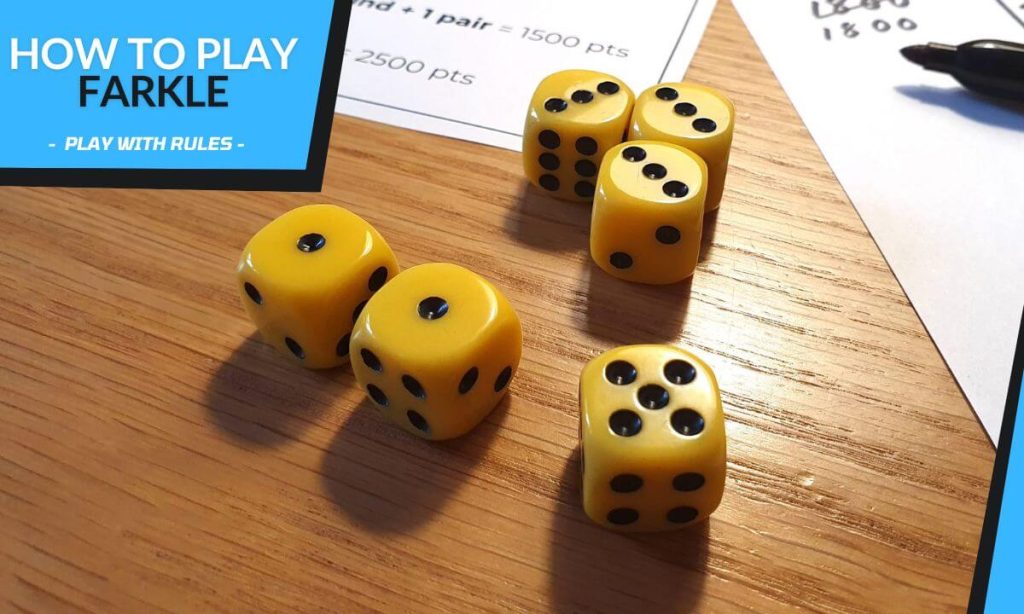Can you name the most fun dice game ever- a game that combines luck, skill, and strategy and packs a thrill like no other? If your answer is Farkle, then you are absolutely right! Today, we will learn more about this game that everyone has been talking about recently, especially the Farkle Rules.
The game of Farkle is based on the simple structure of dice rolling and scoring with a number of possible combinations that can give you points. The term ‘farkle’ is an exclamation for when a player rolls the dice but doesn’t get point-scoring combinations. But what happens then? Let’s find out more as we learn how to ‘Play With Rules’ a game of Farkle.
Table of Contents
How To Play Farkle?
To play Farkle, you need a minimum of 3 players (there is no upper cap on how many players can play together), 6 dice, a scoring sheet to keep the players’ scores, and a pencil/pen. Players choose the first person to start, and then the game proceeds as desired (clockwise).
Each player rolls all 6 dice together and tries to get point-scoring combinations so that they can score 10,000 points before everyone else, per Farkle rules. If they don’t end up with a point-scoring combination, they shout ‘Farkle,’ which means they forfeit all of the points they scored in that round. The way to win in this game is to realize when to stop pushing the luck and when to go all out.

Objective
Each player’s objective in Farkle is to score 10,000 points faster than the others and protect the lead. Keep in mind that avoiding farkling is equally important as scoring. Players need to assess when and how much risk to take to maximize their chances of winning. Curious to know how to play Farkle? Then, let’s dig into the rules of Farkle.
Rules Of Farkle
At a glance, a game of Farkle barely has any rules. It’s mostly about rolling the dice with the aim of maximizing the score with the right combinations while avoiding Farkling. That being said, the mechanics of the game aren’t all that elementary. The game has interesting nuances that make it much more than just a game of luck. Let’s learn more about the game of Farkle and its associated rules. Here are some of the general Farkle rules:
- Use a dice and roll it to decide who goes first to ensure a fair chance.
- Players need to roll all 6 dice together during their turn.
- Once the dice have been rolled, the players can decide which dice to keep aside. These dice/combinations of dice are the point-scoring dice, and the points they carry will be noted down, per Farkle Rules.
- Then, the rest of the dice that haven’t been kept aside (not point-scoring dice) will be rolled again.
- The players may continue to put aside point-scoring dice and roll the rest until they Farkle or decide to stop themselves.
- Farkle rules state that players can choose to stop and register their score at any point during their chance. They do not need to keep rolling the dice.
- But if a player ‘Farkles,’ they automatically lose all the points scored only during that round.
- Players take turns scoring until one reaches 10,000 (the winning score). After this, every other player is given a chance of one turn each to match or surpass the winner’s score.
- On the first turn, the first player rolling the dice needs to score at least 500 points for the game to start. This applies to the first turns of every active player.
- If a player ‘Farkles’ on the first turn and doesn’t score 500, their score remains zero, and they can try again on their next turn.
- If a player ends up with a ‘hot dice’ (explained later below), then they can roll all 6 dice again immediately or choose to play it safe. However, if they Farkle, they lose all points accumulated in that round, per the rules of Farkle.
Points & Combinations
Since you have learned about the rules of this game, now let’s discuss how to play Farkle and keep track of your scores. The key is to score as many points as possible by landing particular dice combinations. Each dice combination/dice has a specific point or score associated with them/it. Let’s find out what they are:
- Single 1 = 100 points
- Single 5 = 50 points
- Three 1s = 1,000 points
- Three 2s = 200 points
- Three 3s = 300 points
- Three 4s = 400 points
- Three 5s = 500 points
- Three 6s = 600 points
- Four dice of any number = 1,000 points
- Five dice of any number = 2,000 points
- Six dice of any number = 3,000 points
- 1-6 straight (Rolling 1, 2, 3, 4, 5, and 6 in a single throw) = 1,500 points
- Three pairs (e.g., Two 1s, two 5s, and two 6s) = 1,500 points
- Four of any number with a pair (e.g., Four 2s and two 1s) = 1,500 points
- Two triplets (e.g., Three 3s and three 4s) = 2,500 points
- Hot Dice = All 6 dice become point-scoring dice (e.g., three 1s and three 6s, two three-pairs, etc.)
With this, you have learned the basic scoring method of the game. Now, it is time to learn about the different terms associated with the game and some exciting variations you can try:

Alternative Scoring
The standard scoring rule has been explained above. Once you get the hang of it, you can try more advanced scoring combinations to make the game ten times as fun (maybe even challenging). These are some of the alternative ways of scoring:
- Three Pairs = 600, 750, 1,000, or 1,500 points
- Four-of-a-kind = 1000 points / 4X Three-of-a-kind value
- Five-of-a-kind = 2000 points / 6X Three-of-a-kind value
- Six-of-a-kind = 3000 points / 8X Three-of-a-kind value
- Six 1s = Player wins
- Two Triplets = 2500 points
- Three 1s / Pocket Farkle = 300 points
- Straight = 0, 1200, 2000, or 2500 points
Alternative Farkle Rules
You can obviously follow the standard rules of farkle and have a blast, but if you think you want to shift it into the next gear, there are certain variations in rules of this game that you can play with. They are as follows:
- Opening Score—Instead of 500 as the minimum opening score, you can opt for 350, 400, or 450 to start the game faster.
- Winning Score—Depending on the players, a 10,000-point game can seem long-drawn or short. You can play for 20,000 points or 5,000.
- Compulsory Hot Dice Roll – If a player rolls all point-scoring dice on a single turn (all 6 dice are point-scoring), then that player must roll all 6 dice again.
- 3 Farkles – If a player Farkles 3 times consecutively, they lose 1,000 points, per Farkle rules.
- Toxic Twos – If a player rolls four or more 2s in a single roll, then their entire round’s point is canceled.
- Welfare—According to the rules of Farkle, the winning player must have exactly 10,000 points. If the winning player scores more than 10,000 points, then the points scored for that round are given to the player with the lowest score.
- Teammate Farkle—In this alternative method, players team up and sit opposite each other. The total score to be played is 20,000.
- Piggyback Version (High Stakes) – Play the piggyback version of this game, which is double the fun because of the higher stakes. In this modification, the first player throws all 6 dice and keeps aside only a few dice for scoring. If the second player can use the dice left from the previous throw (the dice that are not point-scoring) and get a point combination, they get awarded 1000 points on top of whatever score they accumulate from that throw, per modified Farkle rules.
- Five-Dice Farkle – Reduce the number of dice to eliminate a few point-scoring combinations. For example, you can play with only 5 dice, thereby removing a few combinations but increasing the odds of a straight, making the Farkle score easy.
Farkle
The game has been named after its penalty, which goes to say a lot about how thrilling it can be. Farkle is basically when a player rolls the dice, but none of those above combinations are accumulated. By ‘farkling,’ a player ends up losing/forfeiting all the points that they had collected in that round. This means that a player can have ‘hot dice’ or the highest score in a round. But by the end of their turn, if they end up with no point-scoring combinations, they ‘Farkle’ and lose all the points they had acquired in that round, per Farkle rules.
Variations
There can be so many different variations of this great game, and the best part is you can come up with one of your own by just altering Farkle rules a bit. Here are some popular variations of Farkle that you can try:
Tips & Strategies
A lot of people believe that Farkle is all about luck. That is absolutely not true! There is luck involved, but one needs a sound strategy as well. In this section, we shall talk about some really useful tips and techniques that might help you win your next game of Farkle:
- Just because you are on a roll and have hot dice doesn’t mean you need to throw again. The primary objective is to avoid ‘farkling’ while also scoring.
- Most people tend to play aggressively near the end of the game. This can either backfire or help the player win. Assess the previous rounds and the other players’ scores before you gamble.
- Depending on the stage of the game, decide which dice to put aside. For example, if you roll a combination of 1, 2, 5, 5, 5, 4, you can decide whether to keep the 1 and the three 5s and roll the rest or keep the three 5s and roll all of the rest again.
Did You Know?
- Farkle’s origins can be traced back to the ancient times when dice games were popular. The modern adaptation of the game is believed to have originated in the United States during the mid-20th century.
- There is no upper cap on the number of people who can play Farkle at the same time. With more players, the game usually lasts longer, and the Farkle score also intensifies.
- Farkle is played by different communities in different parts of the world. The game obviously also has various names, such as Zonk, Farkel, and Dix Mille.
- Farkle became so popular that digital versions of this game are available on mobile phones and other digital devices.
FAQs
How many players can play Farkle?
As per the Farkle rules, the minimum number of players required to play is two. However, you can have a lot more players, and that is when it gets really fun!
Can I roll again after scoring?
Yes, of course, you can roll after scoring! However, be careful lest you Farkle and give up all your points from that round.
How many dice are in Farkle?
Six regular dice with six sides are used in Farkle.
How many rolls do you get in Farkle?
Every player gets three rolls per turn in a standard Farkle game. For the first roll, players need to roll all 6 dice. Then, they can set aside one scoring die for every turn following that. They can choose to continue to roll the rest of the dice. If, at any point, a player fails to set aside a scoring die, they ‘Fakrle’ and lose all their points.
Conclusion
All in all, Farkle is easily one of the most entertaining games you can play with menial set-up and explanation. It is elementary to understand and play, which is why it is also one of the most popular dice games on the planet. Play smart because no matter what most people say, Farkle is not all about luck. It requires strategy and decision-making skills while also playing per Farkle rules. So the next time you are on ‘hot dice,’ think twice before you roll again!
Now that we have learned about the Farkle rules, let’s learn about another sport, shall we? How about Softball Rules? Click here to learn the rules!

